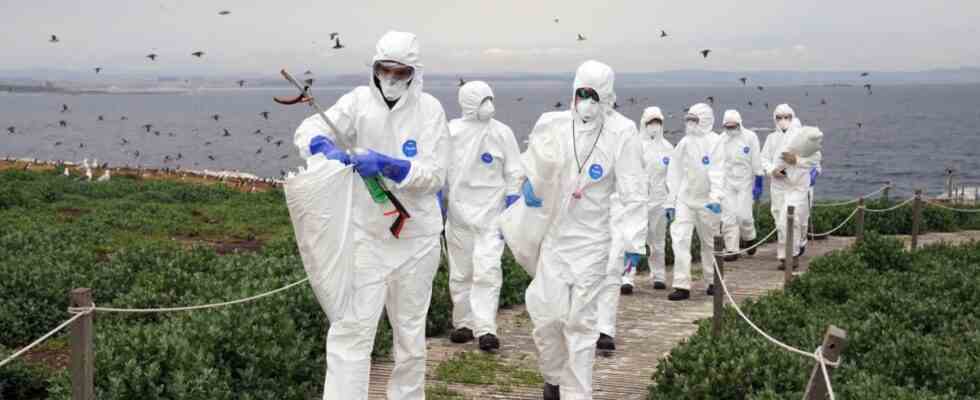For the first time, outbreaks of bird flu also occurred in Europe in the summer. The EU health authority ECDC recently spoke of the worst bird flu epidemic in Europe. How does it go from here?
Is there a particularly strong winter wave?
According to Timm Harder, this is difficult to predict. At least there is a risk of another wave, says the head of the National Reference Laboratory for Avian Influenza at the Friedrich Loeffler Institute (FLI) near Greifswald. Bird migration has begun and is approaching its peak. “Animals from different geographical origins and species are now coming together in a small space at this time. And of course this is an ideal opportunity for a virus to find other hosts.”
When is usually bird flu season in Europe?
According to Harder, bird flu was rampant in recent years, mainly between October and April, due to bird migration. In 2021 there were cases for the first time in summer, especially in northern Europe. But not to the same extent as in 2022. “This summer the whole concept was almost completely overturned.”
Which birds have died in the past few months and where?
According to the expert, colony-breeding seabirds have been hit most recently: terns and gannets on the North Sea and cormorants on the Baltic Sea. Further north, for example on the coasts of Scotland, Norway, the Faroe Islands to Iceland and Spitsbergen, gull species in particular were also affected. For the North Sea alone, Harder assumes that tens of thousands of wild birds have fallen victim to the virus.
How has the epidemic affected poultry farms?
In poultry, there were massive outbreaks in turkey farms in the north of Italy in early summer, says Harder. Duck husbandry was particularly affected in France. On the one hand, it is unusual that this time Spain and Portugal are also affected. There have also now been many outbreaks across poultry sectors in the UK. In Germany there have been sporadic outbreaks in holders over the summer. Chickens were predominantly affected, says Harder. “Layer husbandry was usually the case.” But geese and turkey farms were also affected in this country.
How high is the risk for companies in this country?
According to the FLI risk assessment from the beginning of July, the risk of inputs from coastal holdings is high and otherwise low. However, according to Harder, there are signs that the infection is spreading from the coasts, where it mainly occurred over the summer, to the whole of Germany again. The past seasonal epidemics in winter would have mostly extended to all of Germany. He expects an increasing risk also for companies away from the coasts and a corresponding adjustment of the risk assessment.
Are stocks or even species endangered in Germany?
Danger is seen at least for stocks. In this context, Martin Rümmler, consultant for bird protection at the German Nature Conservation Union (Nabu), referred to the northern gannet, which breeds only on Helgoland in Germany. The colony was badly affected. If it disappeared, the species would have become extinct in Germany. Harder is concerned about species that grow older but produce comparatively few young per litter. Losses are harder to replace here. He also thinks of birds of prey, which can become infected by eating infected animals.
Why is the recent epidemic so dramatic?
According to Harder, this has not yet been clarified. “There are many attempts at explanations. It starts with climate change and changes in wild bird behavior.” The sheer amount of the circulating virus is also mentioned. It is sometimes assumed that the viruses that have spread over the summer are more fit. “But there isn’t really hard evidence for any of these assumptions.”
Do one or more variants circulate and could new ones emerge?
Harder says you see a relatively uniform virus spread across Europe. This prevailed in advance. “We actually saw the great variability of different virus lines in the 20/21 season.” Theoretically, new variants could also be introduced with the migration of birds. Traditionally, such entries from the Eurasian region, such as Russia and Siberia, have been the trigger for bird flu waves. However, there is relatively little data on what happened in Russia over the summer.
What about the risk for humans?
In the past, according to Harder, there had also been deaths in people during epidemics, especially in Southeast Asia or Egypt. However, the ECDC recently assessed the risk for the population as low. According to Harder, infections in humans have recently been absolute exceptions and have remained without serious illness. The danger could increase if the virus mutates. Cases of mammals believed to have died of avian influenza after eating infected birds have also been seen across Europe. These sporadic cases suggested that protection and caution were important when there was close contact, such as collecting birds.
Can one speak of a pandemic?
Yes, with regard to wild birds, Harder speaks of a pandemic. As in 2014, the virus is currently rampant in North America. It was probably carried there by wild birds over Iceland, Greenland and Newfoundland in autumn 2021. It has spread west to the Pacific Ocean and south to Florida. With the current bird migration in North America, there is concern that the virus will also reach Central and South America. According to Harder, that would be “the next wall that the virus would break through”.

